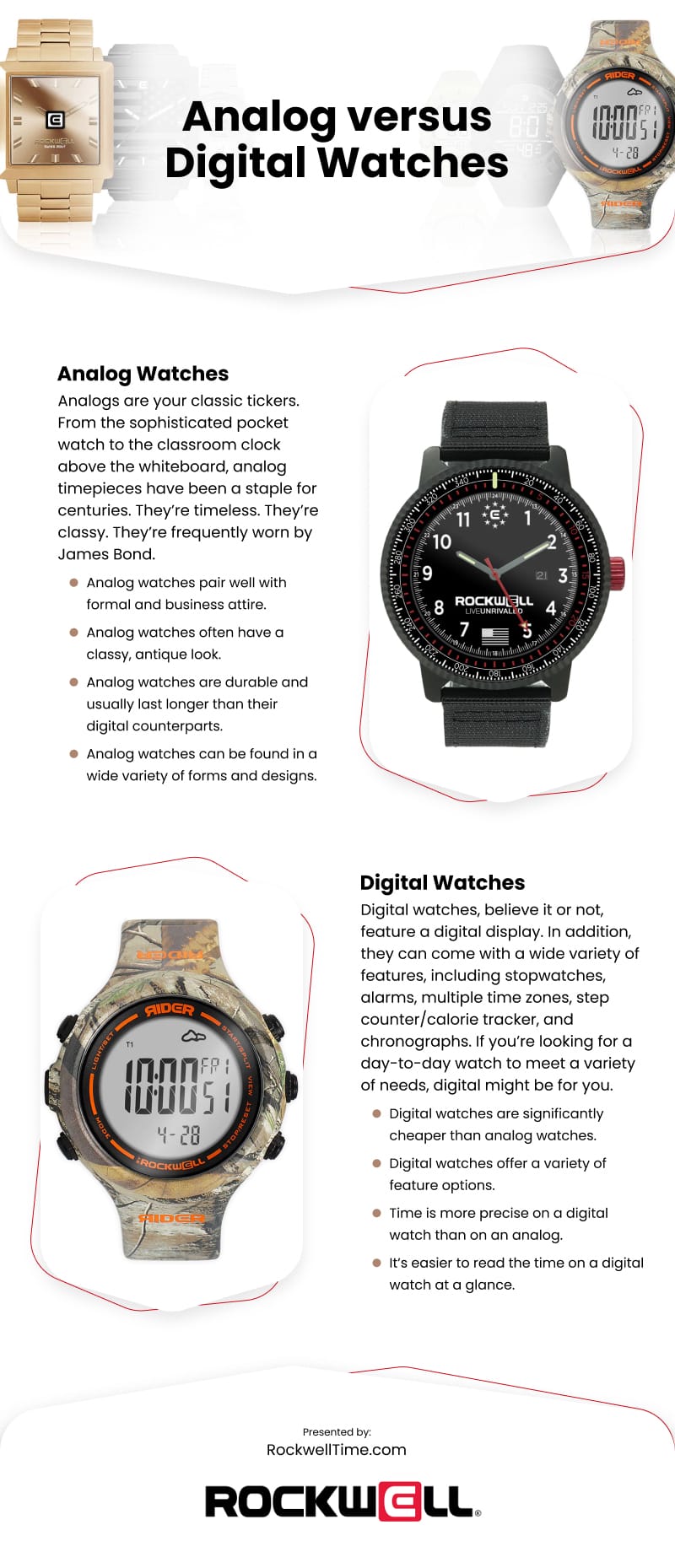Analog vs. Digital…what’s the difference?
We get it, it’s not a question you want to ask in a watch shop, surrounded by timepiece connoisseurs and that one sales guy who could go on about the latest high end watch for days. So, you’ve taken to Google. You’ve decided you’ve got to know before you go. Smart move.
Here at Rockwell Time, we’ll spare you the judgemental stares and give you the 4-1-1 on all things analog and digital, the pros and cons of each, and how to pick a watch that’s right for you.
Analog: What is it?
Analogs are your classic tickers. From the sophisticated pocket watch to the classroom clock above the whiteboard, analog timepieces have been a staple for centuries. They’re timeless. They’re classy. They’re frequently worn by James Bond.
But how do they work?
Analog watches can feature either a quartz piece or spring mechanism beneath the face–which is wound up either by the wearer or, in the case of automatic watches, by the movement of the wearer’s wrist. The spring slowly releases energy, moving a set of gears which cause the big hand and little hand to run steadily around the watch face. Because these watches require concise mechanics, they are often crafted by hand.
Pros
- Analog watches pair well with formal and business attire.
- Analog watches often have a classy, antique look.
- Analog watches are durable and usually last longer than their digital counterparts.
- Analog watches can be found in a wide variety of forms and designs.
Cons
- Precision can be tricky, so your timing might be a few seconds off (if it’s not a Rockwell).
- Due to the craftsmanship required to assemble an analog watch, they can cost a pretty penny.
- You’ve got to be a pro at reading traditional clocks, especially when there are Roman numerals involved.
- Your analog watch won’t come with a plethora of features such as alarms, thermometers, or heart rate monitors.
How to Find the Right Analog Watch
So, you’ve decided that the classic look is for you. You want to feel like James Bond but might not be ready to invest in a Rolex or Omega. How do you figure out which watch is right?
First, determine your budget. A department store analog can run as low as $20 (though you might be replacing it in the near future…), while luxury automatic watches luxury automatic watches can run $25,000. The budget is up to you, but remember you often get what you pay for. A quality timepiece should come with an equally impressive warranty to protect your purchase.
Next, decide on the look and fit that best suits your style and needs. Are you into that tactical look, or do you prefer sleek and classic? Square face or round face?
Finally, determine the kind of band you prefer. Bands can be made from a variety of materials, such as leather, silicone, silver, gold, nylon, stainless steel, and more.
The Digital Difference
Digital watches, believe it or not, feature a digital display. In addition, they can come with a wide variety of features, including stopwatches, alarms, multiple time zones, step counter/calorie tracker, and chronographs. If you’re looking for a day-to-day watch to meet a variety of needs, digital might be for you.
Pros
- Digital watches are significantly cheaper than analog watches.
- Digital watches offer a variety of feature options.
- Time is more precise on a digital watch than on an analog.
- It’s easier to read the time on a digital watch at a glance.
Cons
- Digital watches can have a shorter lifespan compared to analog watches.
- Digital watches typically require you to change the battery from time to time.
- Digital watches are more casual in appearance and might not be appropriate for every occasion.
How to Find the Right Digital Watch
First things first, you’ll want to determine your budget. You can find a cheaper digital watch at a department store, but it will be basic as far as features go. A higher-end digital watch will run you a few hundred dollars, but it is still considerably cheaper than an analog watch.
Next, decide which features will be most beneficial, given your lifestyle. If you’re looking for a watch to fit your athletic activities, consider purchasing a digital sports watch with a step counter and calorie tracker. If your job requires you to communicate with people in other parts of the country or world, a watch that features world time zones would be helpful. Or, if you like to hit the snooze button a few too many times in the morning, you might need a watch with multiple alarms.
Finally, determine the style and material you’d like for your watch and band. While digital watches typically have a casual appearance, you can find them in stainless steel or other metals for a more classic and elegant look.
Whatever your style, budget, or lifestyle, rest assured that there is a watch for you. And now that you know the difference between analog and digital, you can stroll into that watch shop or browse online watch retailers with confidence.
Infographic
Embark on a watch exploration with our insightful infographic on analog and digital timepieces. Analog watches, with their timeless elegance, operate through intricate mechanics, complementing formal attire and offering durability. However, precision may vary, and features can be limited. On the other hand, digital watches, known for affordability, boast modern features and precise timekeeping. Consider factors like lifespan and appearance when selecting your ideal watch. Discover personalized tips for finding the right analog or digital watch based on your budget and lifestyle preferences.

